
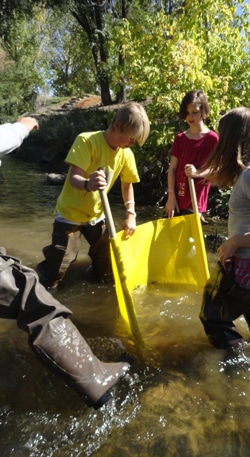 When was the last time you were involved in completing a project for work that didn’t require collaboration? Probably a long time ago, if ever. Chances are that most of your important projects require you to collaborate in significant ways with your colleagues. Even though collaboration is essential to your work, it is unlikely that you are operating from agreed-upon best practices for working and talking together. The real world demands that employees enter the workforce with the skills they need related to teamwork, problem-solving, interpersonal relationships, and oral communication. In fact, over the course of the last 30 years, these four skills have moved to the very top of Fortune 500’s list of most valued characteristics. (Richards, n.d.). Given this demand, we as educators must ensure that our students develop and use skills like collaboration effectively when they enter the workforce.
When was the last time you were involved in completing a project for work that didn’t require collaboration? Probably a long time ago, if ever. Chances are that most of your important projects require you to collaborate in significant ways with your colleagues. Even though collaboration is essential to your work, it is unlikely that you are operating from agreed-upon best practices for working and talking together. The real world demands that employees enter the workforce with the skills they need related to teamwork, problem-solving, interpersonal relationships, and oral communication. In fact, over the course of the last 30 years, these four skills have moved to the very top of Fortune 500’s list of most valued characteristics. (Richards, n.d.). Given this demand, we as educators must ensure that our students develop and use skills like collaboration effectively when they enter the workforce.
The good news is that the education field is currently buzzing with research and discussion about the importance of explicitly teaching these kinds of skills. The Common Core standards and other related initiatives are re-energizing the conversation and raising the bar, not just in terms of rigorous academic content, but also in how students come to master that content through what is widely referred to as “student agency”—a set of character-related academic mindsets and learning strategies that contribute to students’ academic success. In fact, the groundbreaking report from Consortium on Chicago School Research (CCSR), “Teaching Adolescents to Become Learners—The Role of Noncognitive Factors in Shaping School Performance,” provides a comprehensive literature review showing definitively that student agency has a significant, positive impact on academic achievement (2012). The research makes sense. Consider the significant role collaboration skills play in a vibrant classroom characterized by deep learning: when students follow routines and norms that allow them to navigate discussion and work, they spend significantly more time thinking critically.
What is not yet being discussed, researched, and documented widely is how schools and teachers can intentionally integrate student agency with academics in ways that help students develop the skills they need. (Farrington et al., 2012). In Paul Tough’s recent book How Children Succeed, he quotes Angela Duckworth—Psychology Professor and respected researcher in the field of student agency—as she notes, “thinking and talking about character isn’t enough, specifically for adolescents. It’s one thing to know abstractly that you need to improve your grit or your zest or your self-control. It’s another thing to actually have the tools to do so” (2012, p. 92). Though many schools embrace teaching character or social skills, most approach character as a separate set of skills or list of values, often loosely defined and supported by “canned” curriculum with external positive reward systems. Increasingly, however, educators are seeking ways to instruct specifically to these skills and weave them in with academics in authentic ways that mirror healthy professional interactions—like collaboration.
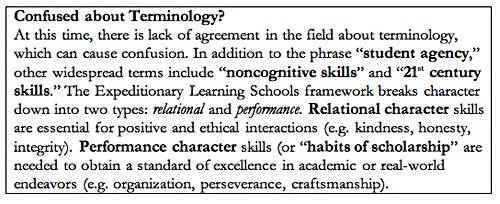
The research of Duckworth and others shows us that performance character in particular can be taught and learned, just as academic content and skills are. Tough quotes Duckworth discussing an idea brought forth by American philosopher and psychologist William James: “Habit and character are essentially the same thing. It’s not like some kids are good and some are bad. Some kids have good habits and some have bad habits. Kids understand it when you put it that way, because they know that habits might be hard to change, but they’re not impossible to change” (2012, p. 94). The term “habit” is powerful. It emphasizes the concept of agency—the ability humans have to make choices about their behaviors—and the notion of practice.
In Expeditionary Learning schools—a non-profit organization that partners with schools, districts, and states to continuously improve education for all students—performance character skills, called “habits of scholarship,” are taught at the classroom and whole-school level. Lasting habits will not flourish at the “I” level unless they live at the “we” level first, so the journey begins by establishing school culture, structures, and systems that emphasize the integration of the habits with academics. Habits of scholarship are agreed upon school-wide and taught through every course rather than approached as a separate, stand-alone program or curriculum. Also essential is that all adults in the building deeply understand, practice, and hold themselves and one another accountable to the same set of habits while modeling a growth mindset. It is the adults in the building who establish and uphold the essential “ecology” of agency and habits at a school.
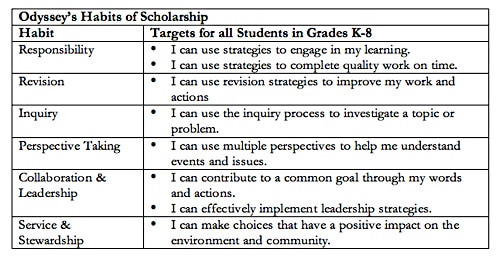
What follows is one case study from an Expeditionary Learning school that helps address some of the burning questions framed above; specifically, it shows how one teacher supported students in the development of the habit of collaboration.
At the Odyssey School, a K-8 Expeditionary Learning school in Denver, Colorado, 6th graders engage in an in-depth study of the impact of humans on the health of their local river as way to meet standards in science and language arts. In teams, students develop and implement a scientific study of the river. You can probably imagine what it could look like for a group for 6th graders to go off to the river to implement a scientific study. At best: the team works together to collect data with precision, paying attention to the variables that must be controlled to collect accurate data; at worst: the team tromps around in the river, collects some data (not managing to control any of the variables), disagrees about who will do which job, and loses expensive lab equipment.
Any veteran teacher knows that a plan is needed to support students’ fieldwork success. The mistake that many teachers make is that they try to control every facet of the experience for kids by outlining a list of scientific procedures, assigning students specific roles, and managing any disagreements that arise. You may be thinking, why is this a mistake? These strategies will certainly help the day run smoothly. However, the missed opportunity is that when the teacher tightly designs the experience, students miss out on learning opportunities. Specifically, students miss opportunities to practice negotiating who will do what, sharing their ideas, and actively listening to others’ ideas. Each skill is an important aspect of strong collaboration. What is lost when there is too much teacher control is that students have less opportunity to practice and learn about the habits of collaboration and self-directed learning—two skills considered necessary to support students in mastering core academic content (EPIC, 2010).
What if instead, the teacher supports students to develop the skills necessary to not only collaborate effectively, but also develop their skills in self-directed learning through careful choices about curriculum, instruction, and assessment? What if the river day is a culmination of their work toward developing these skills, and instead of the teacher micro-managing fieldwork, he is watching see how well his instruction and support worked? What if students were in charge of their learning, both about the scientific content and habits of scholarship?
Let’s take a look at how Jon Exall, a 6th grade teacher at Odyssey, did just this. First, because he knew that students would need to develop crucial collaboration skills, he crafted a learning target linked to both the school-wide habit of “Collaboration and Leadership” as well as to Common Core ELA Speaking and Listening standard 1 (“[Students] engage effectively in a range of collaborative discussions with diverse partners”): I can coordinate my actions and efforts with the actions and efforts of my research team to ensure quality data collection. This learning target was shared with students at the outset of instruction and was in front of them throughout the study; it was just as important as the science content targets addressed concurrently.
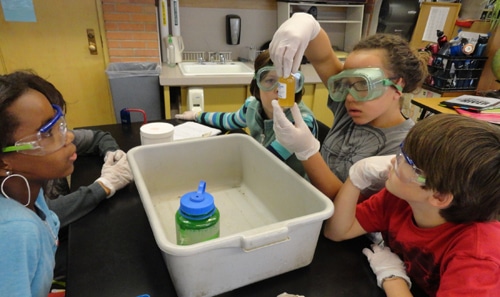
Simply having a learning target wasn’t enough, however. Jon knew that he needed to build a vision with the students about what it would look like to hit that target. To do this, students watched video of themselves and others working together both in the classroom and in the field. Through video observation and reflection, they developed descriptors for “accomplished” collaboration. They revised the descriptors until they felt
they had them right, resulting in a rubric that provided the class with a commonly held vision of what it looked like to hit the target.
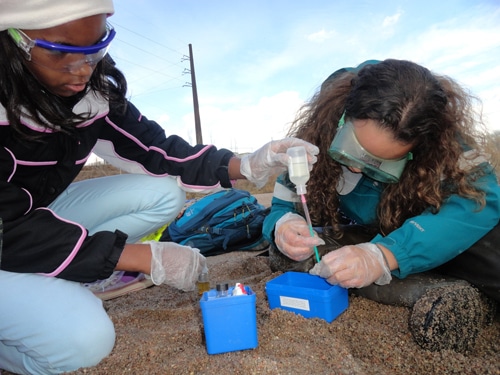
Students used a rubric (see Appendix A) to set goals, give each other feedback, and practice items on the rubric that were tricky for them. Because of Jon’s curriculum design, students had plenty of opportunities to practice their collaboration; they practiced as they learned how to control variables, made a plan for their work on the next river day, and learned the scientific skills necessary to measure biotic and abiotic factors in a river. As a result, the river day went off without a hitch. Jon reports, “Students rose to the occasion in terms of collaboration on fieldwork. They really had to. It was the ‘high stakes’ opportunity to demonstrate the habit.”
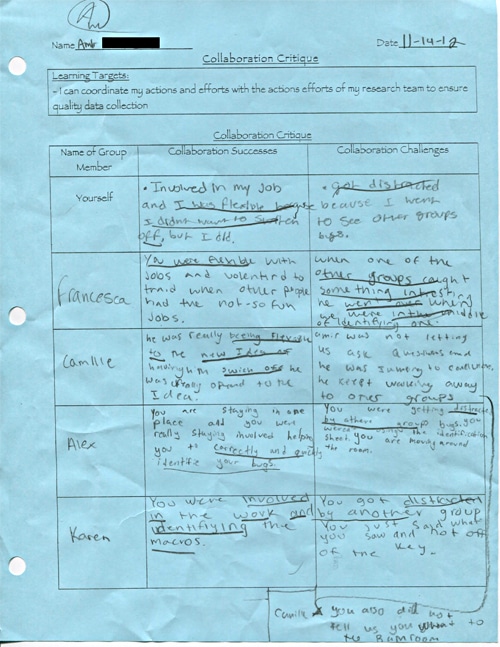
Amir, a student new to the school, reflected on his experience learning to collaborate with his group: “Some of my work [shows] that I am developing…. I am good at sharing ideas with my crew…, but I was also distracting to my crew, so I should work on that.” While this may seem far from proving that Jon’s technique helped Amir, let’s look back at the first days of the project. While sorting macroinvertebrates, Amir’s table group unanimously gave him the feedback that while he was good at “getting his voice into the crew,” he also interrupted people. Over time, his peers began to give him more feedback about “listening thoughtfully” to what others were saying, and “being flexible.” One month later, Francesca wrote to Amir: “I think you were really flexible and you advocated for yourself and me. You gave gentle reminders to Alex, but then you apologized for being a little harsh.” While the change may seem subtle, the focused feedback from his peers about what he did well as well as what he could change, along with a lot of opportunity to reflect and practice, helped Amir begin to see success.
This example shows the synergistic nature of improving both habits of scholarship and academic achievement. In order to successfully collect authentic data at a local river (as well as engage in other science lessons held in school), students needed to develop both character and academic skills. They were driven to develop their skills of collaboration because of the meaningful academic content. They cared about the quality of their data because they cared about the health of their local river. They knew it was important to work together, and having a clear target, common language, and several opportunities for self-directed learning allowed them to succeed and help one another improve.
Amir knows that he has to keep working on the habit of collaboration. He reports, “My next step for the future is to not distract my crew. If I have a question, just ask, but don’t get off topic with it. And I would love to keep sharing ideas. I love getting my voice out and heard.” Amir may not have reached “Accomplished” on every criterion on the rubric yet, but the power of this example is that Amir has grown his own vision about what it means to work well with a group; perhaps more importantly, he has specific goals about what he can improve the next time that he encounters opportunities to collaborate. In fact, this is exactly what Jon intended. He explains that this collaboration study will help students in the future because, “it gives them vocabulary to begin with and will give them a reference point to grow from. They’ll know what is tricky for them as a collaborator and what they are generally successful with. As a result, they can both improve from that point and offer their strengths and experience to future group members.”
Thankfully, Jon will provide Amir, and his entire crew, with plenty more opportunities to practice. He’ll continue to engage students with meaningful science content. He will keep using explicit learning targets derived from standards. The class will continue to use their rubric to drive reflection and feedback. And, though students have room for growth, Jon knows he won’t need to control fieldwork days with canned roles and rules, because students have taken ownership about the work they have yet to do—both in science and collaboration. This type of teaching and learning results in lasting change—learning that students will be able to transfer beyond a single situation to a diffused set of situations, precisely what is necessary when helping students develop true habits of scholarship that will prepare them for college and beyond.
Educational Policy Improvement Center (EPIC). (2010). Deeper Learning Defined. Retrieved from https://www.hewlett.org/library/grantee-publication/deeper-learning-defined.
Farrington, C.A., Roderick, M., Allensworth, E., Nagaoka, J., Keyes, T.S., Johnson, D.W., & Beechum, N.O. (2012). Teaching adolescents to become learners. The role of noncognitive factors in shaping school performance: A critical literature review. Chicago: University of Chicago Consortium on Chicago School Research.
Richards, Leigh. (n.d.). Characteristics of a Successful Employee for a Fortune 500 Company. Retrieved from https://www.ehow.com/list_6848145_characteristics-employee-fortune-500-company.html.
Tough, P. (2012). How children succeed. Boston, MA: Houghton Mifflin Harcourt.
Appendix: Collaboration Rubric

 When was the last time you were involved in completing a project for work that didn’t require collaboration? Probably a long time ago, if ever. Chances are that most of your important projects require you to collaborate in significant ways with your colleagues. Even though collaboration is essential to your work, it is unlikely that you are operating from agreed-upon best practices for working and talking together. The real world demands that employees enter the workforce with the skills they need related to teamwork, problem-solving, interpersonal relationships, and oral communication. In fact, over the course of the last 30 years, these four skills have moved to the very top of Fortune 500’s list of most valued characteristics. (Richards, n.d.). Given this demand, we as educators must ensure that our students develop and use skills like collaboration effectively when they enter the workforce.
When was the last time you were involved in completing a project for work that didn’t require collaboration? Probably a long time ago, if ever. Chances are that most of your important projects require you to collaborate in significant ways with your colleagues. Even though collaboration is essential to your work, it is unlikely that you are operating from agreed-upon best practices for working and talking together. The real world demands that employees enter the workforce with the skills they need related to teamwork, problem-solving, interpersonal relationships, and oral communication. In fact, over the course of the last 30 years, these four skills have moved to the very top of Fortune 500’s list of most valued characteristics. (Richards, n.d.). Given this demand, we as educators must ensure that our students develop and use skills like collaboration effectively when they enter the workforce.
The good news is that the education field is currently buzzing with research and discussion about the importance of explicitly teaching these kinds of skills. The Common Core standards and other related initiatives are re-energizing the conversation and raising the bar, not just in terms of rigorous academic content, but also in how students come to master that content through what is widely referred to as “student agency”—a set of character-related academic mindsets and learning strategies that contribute to students’ academic success. In fact, the groundbreaking report from Consortium on Chicago School Research (CCSR), “Teaching Adolescents to Become Learners—The Role of Noncognitive Factors in Shaping School Performance,” provides a comprehensive literature review showing definitively that student agency has a significant, positive impact on academic achievement (2012). The research makes sense. Consider the significant role collaboration skills play in a vibrant classroom characterized by deep learning: when students follow routines and norms that allow them to navigate discussion and work, they spend significantly more time thinking critically.
What is not yet being discussed, researched, and documented widely is how schools and teachers can intentionally integrate student agency with academics in ways that help students develop the skills they need. (Farrington et al., 2012). In Paul Tough’s recent book How Children Succeed, he quotes Angela Duckworth—Psychology Professor and respected researcher in the field of student agency—as she notes, “thinking and talking about character isn’t enough, specifically for adolescents. It’s one thing to know abstractly that you need to improve your grit or your zest or your self-control. It’s another thing to actually have the tools to do so” (2012, p. 92). Though many schools embrace teaching character or social skills, most approach character as a separate set of skills or list of values, often loosely defined and supported by “canned” curriculum with external positive reward systems. Increasingly, however, educators are seeking ways to instruct specifically to these skills and weave them in with academics in authentic ways that mirror healthy professional interactions—like collaboration.

The research of Duckworth and others shows us that performance character in particular can be taught and learned, just as academic content and skills are. Tough quotes Duckworth discussing an idea brought forth by American philosopher and psychologist William James: “Habit and character are essentially the same thing. It’s not like some kids are good and some are bad. Some kids have good habits and some have bad habits. Kids understand it when you put it that way, because they know that habits might be hard to change, but they’re not impossible to change” (2012, p. 94). The term “habit” is powerful. It emphasizes the concept of agency—the ability humans have to make choices about their behaviors—and the notion of practice.
In Expeditionary Learning schools—a non-profit organization that partners with schools, districts, and states to continuously improve education for all students—performance character skills, called “habits of scholarship,” are taught at the classroom and whole-school level. Lasting habits will not flourish at the “I” level unless they live at the “we” level first, so the journey begins by establishing school culture, structures, and systems that emphasize the integration of the habits with academics. Habits of scholarship are agreed upon school-wide and taught through every course rather than approached as a separate, stand-alone program or curriculum. Also essential is that all adults in the building deeply understand, practice, and hold themselves and one another accountable to the same set of habits while modeling a growth mindset. It is the adults in the building who establish and uphold the essential “ecology” of agency and habits at a school.

What follows is one case study from an Expeditionary Learning school that helps address some of the burning questions framed above; specifically, it shows how one teacher supported students in the development of the habit of collaboration.
At the Odyssey School, a K-8 Expeditionary Learning school in Denver, Colorado, 6th graders engage in an in-depth study of the impact of humans on the health of their local river as way to meet standards in science and language arts. In teams, students develop and implement a scientific study of the river. You can probably imagine what it could look like for a group for 6th graders to go off to the river to implement a scientific study. At best: the team works together to collect data with precision, paying attention to the variables that must be controlled to collect accurate data; at worst: the team tromps around in the river, collects some data (not managing to control any of the variables), disagrees about who will do which job, and loses expensive lab equipment.
Any veteran teacher knows that a plan is needed to support students’ fieldwork success. The mistake that many teachers make is that they try to control every facet of the experience for kids by outlining a list of scientific procedures, assigning students specific roles, and managing any disagreements that arise. You may be thinking, why is this a mistake? These strategies will certainly help the day run smoothly. However, the missed opportunity is that when the teacher tightly designs the experience, students miss out on learning opportunities. Specifically, students miss opportunities to practice negotiating who will do what, sharing their ideas, and actively listening to others’ ideas. Each skill is an important aspect of strong collaboration. What is lost when there is too much teacher control is that students have less opportunity to practice and learn about the habits of collaboration and self-directed learning—two skills considered necessary to support students in mastering core academic content (EPIC, 2010).
What if instead, the teacher supports students to develop the skills necessary to not only collaborate effectively, but also develop their skills in self-directed learning through careful choices about curriculum, instruction, and assessment? What if the river day is a culmination of their work toward developing these skills, and instead of the teacher micro-managing fieldwork, he is watching see how well his instruction and support worked? What if students were in charge of their learning, both about the scientific content and habits of scholarship?
Let’s take a look at how Jon Exall, a 6th grade teacher at Odyssey, did just this. First, because he knew that students would need to develop crucial collaboration skills, he crafted a learning target linked to both the school-wide habit of “Collaboration and Leadership” as well as to Common Core ELA Speaking and Listening standard 1 (“[Students] engage effectively in a range of collaborative discussions with diverse partners”): I can coordinate my actions and efforts with the actions and efforts of my research team to ensure quality data collection. This learning target was shared with students at the outset of instruction and was in front of them throughout the study; it was just as important as the science content targets addressed concurrently.

Simply having a learning target wasn’t enough, however. Jon knew that he needed to build a vision with the students about what it would look like to hit that target. To do this, students watched video of themselves and others working together both in the classroom and in the field. Through video observation and reflection, they developed descriptors for “accomplished” collaboration. They revised the descriptors until they felt
they had them right, resulting in a rubric that provided the class with a commonly held vision of what it looked like to hit the target.

Students used a rubric (see Appendix A) to set goals, give each other feedback, and practice items on the rubric that were tricky for them. Because of Jon’s curriculum design, students had plenty of opportunities to practice their collaboration; they practiced as they learned how to control variables, made a plan for their work on the next river day, and learned the scientific skills necessary to measure biotic and abiotic factors in a river. As a result, the river day went off without a hitch. Jon reports, “Students rose to the occasion in terms of collaboration on fieldwork. They really had to. It was the ‘high stakes’ opportunity to demonstrate the habit.”

Amir, a student new to the school, reflected on his experience learning to collaborate with his group: “Some of my work [shows] that I am developing…. I am good at sharing ideas with my crew…, but I was also distracting to my crew, so I should work on that.” While this may seem far from proving that Jon’s technique helped Amir, let’s look back at the first days of the project. While sorting macroinvertebrates, Amir’s table group unanimously gave him the feedback that while he was good at “getting his voice into the crew,” he also interrupted people. Over time, his peers began to give him more feedback about “listening thoughtfully” to what others were saying, and “being flexible.” One month later, Francesca wrote to Amir: “I think you were really flexible and you advocated for yourself and me. You gave gentle reminders to Alex, but then you apologized for being a little harsh.” While the change may seem subtle, the focused feedback from his peers about what he did well as well as what he could change, along with a lot of opportunity to reflect and practice, helped Amir begin to see success.
This example shows the synergistic nature of improving both habits of scholarship and academic achievement. In order to successfully collect authentic data at a local river (as well as engage in other science lessons held in school), students needed to develop both character and academic skills. They were driven to develop their skills of collaboration because of the meaningful academic content. They cared about the quality of their data because they cared about the health of their local river. They knew it was important to work together, and having a clear target, common language, and several opportunities for self-directed learning allowed them to succeed and help one another improve.
Amir knows that he has to keep working on the habit of collaboration. He reports, “My next step for the future is to not distract my crew. If I have a question, just ask, but don’t get off topic with it. And I would love to keep sharing ideas. I love getting my voice out and heard.” Amir may not have reached “Accomplished” on every criterion on the rubric yet, but the power of this example is that Amir has grown his own vision about what it means to work well with a group; perhaps more importantly, he has specific goals about what he can improve the next time that he encounters opportunities to collaborate. In fact, this is exactly what Jon intended. He explains that this collaboration study will help students in the future because, “it gives them vocabulary to begin with and will give them a reference point to grow from. They’ll know what is tricky for them as a collaborator and what they are generally successful with. As a result, they can both improve from that point and offer their strengths and experience to future group members.”
Thankfully, Jon will provide Amir, and his entire crew, with plenty more opportunities to practice. He’ll continue to engage students with meaningful science content. He will keep using explicit learning targets derived from standards. The class will continue to use their rubric to drive reflection and feedback. And, though students have room for growth, Jon knows he won’t need to control fieldwork days with canned roles and rules, because students have taken ownership about the work they have yet to do—both in science and collaboration. This type of teaching and learning results in lasting change—learning that students will be able to transfer beyond a single situation to a diffused set of situations, precisely what is necessary when helping students develop true habits of scholarship that will prepare them for college and beyond.
Educational Policy Improvement Center (EPIC). (2010). Deeper Learning Defined. Retrieved from https://www.hewlett.org/library/grantee-publication/deeper-learning-defined.
Farrington, C.A., Roderick, M., Allensworth, E., Nagaoka, J., Keyes, T.S., Johnson, D.W., & Beechum, N.O. (2012). Teaching adolescents to become learners. The role of noncognitive factors in shaping school performance: A critical literature review. Chicago: University of Chicago Consortium on Chicago School Research.
Richards, Leigh. (n.d.). Characteristics of a Successful Employee for a Fortune 500 Company. Retrieved from https://www.ehow.com/list_6848145_characteristics-employee-fortune-500-company.html.
Tough, P. (2012). How children succeed. Boston, MA: Houghton Mifflin Harcourt.
Appendix: Collaboration Rubric